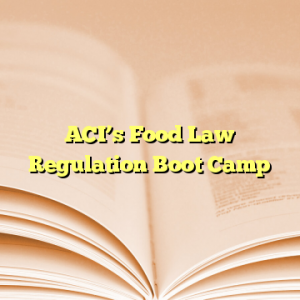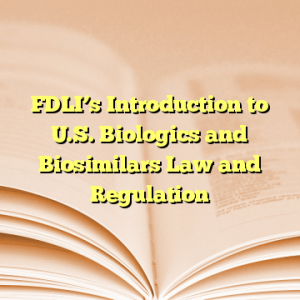By A. Wes Siegner, Jr. –
In what may appear to the uninitiated as a step to cooperate with industry on FDA development of a rational policy for new dietary ingredients (NDIs), FDA is holding a public meeting on October 3 with the goal of developing an authoritative list of old dietary ingredients (ODIs), dietary ingredients on the market before the enactment of the Dietary Supplement Health and Education Act of 1994 (DSHEA). ODIs are dietary ingredients that may be included in dietary supplements, assuming the ingredients are safe, without premarket notification to FDA. In reality, FDA’s October 3 meeting is at best an exercise in futility and a waste of both FDA’s and industry’s time.
FDA’s new leadership should step in to end FDA’s repeated efforts to irrationally and illegally restrict the dietary supplement market, which goes back to the 1960s. Instead of holding meetings, FDA should withdraw its August 2016 “Draft Guidance for Industry; Dietary Supplements: New Dietary Ingredient Notifications and Related Issues” to permit the development of a guidance that is consistent with the plain meaning of DSHEA and congressional intent. FDA should also work with industry to create a list of any dietary ingredients that raise safety concerns in order to remove these ingredients from the market, or to resolve these concerns by requiring that notifications be filed.
We have written extensively in blogposts and comments to FDA about the 30-year history of FDA’s bungling of policies for dietary supplements (see our previous posts here, here, here, and here; and comment here). A brief recap:
In the 1980s FDA attempted to keep dietary supplements, other than traditional vitamins and minerals, off the market through misapplication of the Federal Food, Drug, and Cosmetic Act (FDC Act) “food additive” provisions. When FDA brought seizure actions arguing that even single ingredient dietary supplement products were food additives, two appellate courts rejected FDA’s legal theories, one court stating that they “pervert[ed] the statutory text, undermine[d] legislative intent, and defenestrate[d] common sense,” while the other described FDA’s theory as an “Alice-in-Wonderland approach,” and “an end-run around the statutory scheme.” FDA’s irrational and restrictive approach to supplement regulation led to a popular uprising and the enactment of DSHEA.
DSHEA amended the FDC Act in 1994 to prevent further FDA misuse of the food additive provisions and to create separate and less onerous requirements for dietary supplements in recognition of the important role these products play in public health, and that, unlike conventional foods, they are consumed in limited quantities requiring a different safety analysis.
DSHEA amended the FDC Act to, among other things, (1) make clear that dietary ingredients are not subject to regulation as food additives; (2) exempt dietary ingredients in food marketed before October 15, 1994 from regulation as NDIs; (3) subject NDIs to a premarket notification process (as opposed to a premarket approval process); and (4) exempt from the premarket notification requirement any NDI that is present in the food supply and has not been chemically altered.
FDA issued draft guidance on DSHEA’s NDI requirements in July 2011, which made it clear that FDA intended to apply the provisions of DSHEA in a way that, instead of providing more opportunities for the development and marketing of safe dietary supplements, exerted more control over the market than FDA had asserted by its misuse of the food additive authorities prior to DSHEA.
FDA’s draft guidance caused a firestorm of protest from industry as well as Congress. FDA received over 140,000 pages of comments, mostly critical, among them a strongly worded letter to FDA Commissioner Hamburg from the principal authors of the Dietary Supplement Health and Education Act of 1994 (“DSHEA”), Senators Orrin Hatch and Tom Harkin, requesting that FDA immediately withdraw the draft NDI guidance because it undermined DSHEA in unacceptable ways.
In a June 2012 meeting between FDA and Senators Hatch and Harkin, Commissioner Hamburg committed to issuing a revised draft in order to address the concerns of Congress and industry.
Four years later, in August 2016, FDA published its revised draft, but instead of revising the 2011 draft to fix the policies that were in direct conflict with DSHEA and congressional intent, FDA doubled down on its prior mistakes. FDA significantly lengthened the guidance “to clarify and better explain [its] thinking on some critical issues” and to address “gaps and unclear statements that were subject to confusion and misinterpretation.”
In short, FDA has once again ignored the plain language of the FDC Act as amended by DSHEA, and is seeking to impose requirements on dietary supplements that have no basis in law. Ironically, as a result of FDA’s restrictive NDI policies, companies now wishing to introduce NDIs to the market are first introducing them as conventional food ingredients using the very procedures that DSHEA was intended to replace.
To appreciate the pointlessness of the October 3 meeting, the announced purpose of which is to develop an authoritative list of pre-DSHEA or ODI ingredients, consider the following:
Recognizing the initial importance of ODIs to the implementation of DSHEA, in order to clarify for industry and FDA which ingredients were exempt from notification as ODIs, industry trade associations created, published, and revised lists of ODIs, culminating in a joint list from four trade associations published on September 17, 1999. Rather than use these contemporaneous lists as a guide, FDA has repeatedly dismissed them as unreliable and unsubstantiated.
FDA through its guidance has created irrational barriers to ODI status that are contrary to the wording and intent of DSHEA, including limiting ODIs only to pre-DSHEA dietary ingredients in dietary supplements, a category that of course did not exist prior to DSHEA, and requiring that ODI status not only be established by pre-1994 documentation, but that manufacturers also prove that, in the intervening 23 years, the manufacturing process has not changed, even if the ingredient remains the same.
In addition to ODIs, DSHEA created an exemption from the requirement of NDI notification for any “dietary ingredient present in the food supply.” This provision sensibly exempts food ingredients, which pursuant to DSHEA includes ingredients in dietary supplements, from notification, therefore exempting not just ingredients marketed in food both pre- and post-DSHEA, but also NDIs for which FDA has already been notified.
Now, 23 years after the enactment of DSHEA, if FDA were to challenge any dietary ingredient as an NDI for which notification is required, FDA would not only bear the burden of proving that the ingredient lacks ODI status, but also that the ingredient had not been in the food supply in the intervening 23 years anywhere in the world, a difficult if not impossible burden to meet for those dietary ingredients that have been marketed for substantial periods of time with no safety concerns.
As FDA’s focus should be ingredient safety, the obvious conclusion is that FDA should turn its attention from ODIs and instead work with industry to identify any ingredients for which safety concerns exist, and then, using the existing adulteration provisions of the FDC Act as well as an appropriate interpretation of the NDI provision, either remove these ingredients from the market or require NDI notifications. As this change in focus will require an abandonment of FDA’s long held but ill-conceived views of DSHEA, the necessary change will not likely occur without guidance from FDA’s new leadership, under the watchful eye of Congress.








